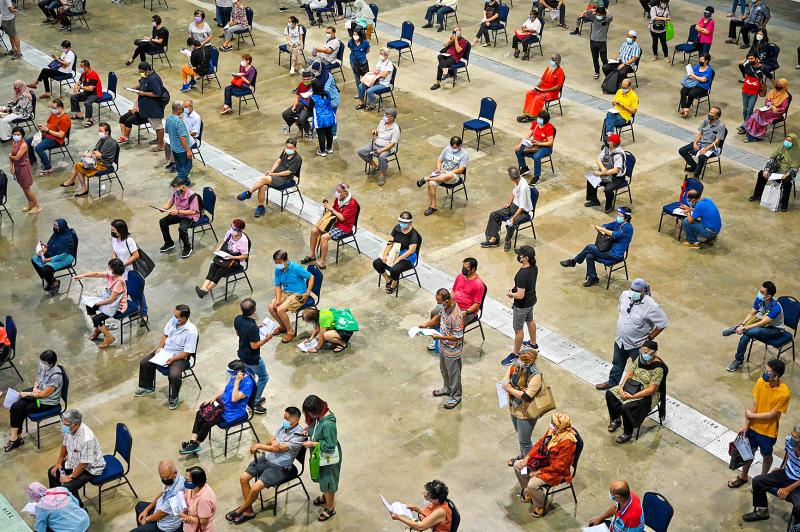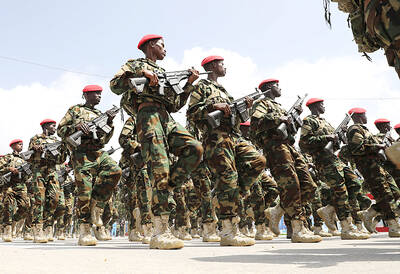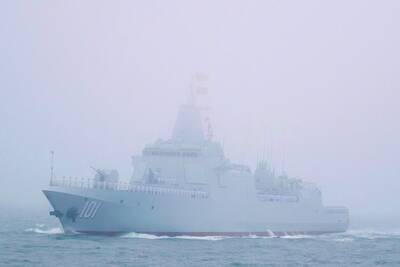A sharp rise in COVID-19 cases from new variants in parts of Southeast Asia that had been less affected by the pandemic has prompted new restrictions, factory closures and attempts to rapidly scale up vaccination programs across the region.
The number of new daily COVID-19 cases in Malaysia has soared past India’s on a per capita basis, while total cases in Cambodia, East Timor, Laos, Thailand and Vietnam have all more than doubled in the past month.
Thailand, which was the second country to record infections after China, had won plaudits for containing its first wave of cases, but its death toll has risen 10-fold over two months — although at 1,031, it is still low by global standards.

Photo: AFP
Adding to concerns, Vietnamese officials revealed the discovery over the weekend of a “very dangerous” combination of Indian and UK COVID-19 variants, which spreads quickly by air.
“COVID-19 infection rates are very alarming in countries across Southeast Asia,” said Alexander Matheou, Asia-Pacific director at the International Federation of Red Cross and Red Crescent Societies.
“The more dangerous and deadly variants highlight the urgent need for much faster global sharing and manufacture of vaccines to contain this outbreak and to help avoid huge mass casualties,” he said.
In the absence of vaccines, containment is the priority.
Vietnam crushed earlier waves — and the country of 98 million has still suffered fewer than 50 deaths — but new distancing measures started in its business hub Ho Chin Minh City yesterday.
In the north of the country, factories supplying global tech firms such as Apple and Samsung are operating below capacity because of outbreaks, industry sources said.
In Thailand, thousands of cases have been found at factories, construction sites and prisons.
As Malaysia ordered a “total lockdown” from today to stem the spread, officials said some factories could keep operating at reduced capacity.
A surge of cases has also been reported near Myanmar’s Indian border — raising concerns about a health system that has collapsed since a coup on Feb. 1.
Malaysia has tried to step up its vaccination campaign, but fewer than 6 percent of people have received at least one dose of a vaccine — barely half the proportion in India.
Some Southeast Asian countries had placed less emphasis on vaccine procurement than Western countries or simply could not afford them and now have limited access.
“With a smaller segment of the population that is protected [by] vaccination, the vast majority of the population remains susceptible,” said Teo Yik Ying, dean of the Saw Swee Hock School of Public Health at the National University of Singapore. “The healthcare systems in several Southeast Asian countries are either at risk of being, or already have been, completely overwhelmed.”
Only Singapore has comparable vaccination rates to Western countries with more than 36 percent of its population getting at least one injection, but the appearance of cases from new variants there has also prompted new closures this month.
Singaporean Prime Minister Lee Hsien Loong (李顯龍) was due to outline a strategy for opening up the country, whose economy depends on its place as a regional business and transport hub.
“The solution: testing, contact tracing and vaccinating, all faster, and more,” Lee said.

END OF AN ERA: The vote brings the curtain down on 20 years of socialist rule, which began in 2005 when Evo Morales, an indigenous coca farmer, was elected president A center-right senator and a right-wing former president are to advance to a run-off for Bolivia’s presidency after the first round of elections on Sunday, marking the end of two decades of leftist rule, preliminary official results showed. Bolivian Senator Rodrigo Paz was the surprise front-runner, with 32.15 percent of the vote cast in an election dominated by a deep economic crisis, results published by the electoral commission showed. He was followed by former Bolivian president Jorge “Tuto” Quiroga in second with 26.87 percent, according to results based on 92 percent of votes cast. Millionaire businessman Samuel Doria Medina, who had been tipped

ELECTION DISTRACTION? When attention shifted away from the fight against the militants to politics, losses and setbacks in the battlefield increased, an analyst said Recent clashes in Somalia’s semi-autonomous Jubaland region are alarming experts, exposing cracks in the country’s federal system and creating an opening for militant group al-Shabaab to gain ground. Following years of conflict, Somalia is a loose federation of five semi-autonomous member states — Puntland, Jubaland, Galmudug, Hirshabelle and South West — that maintain often fractious relations with the central government in the capital, Mogadishu. However, ahead of elections next year, Somalia has sought to assert control over its member states, which security analysts said has created gaps for al-Shabaab infiltration. Last week, two Somalian soldiers were killed in clashes between pro-government forces and

Ten cheetah cubs held in captivity since birth and destined for international wildlife trade markets have been rescued in Somaliland, a breakaway region of Somalia. They were all in stable condition despite all of them having been undernourished and limping due to being tied in captivity for months, said Laurie Marker, founder of the Cheetah Conservation Fund, which is caring for the cubs. One eight-month-old cub was unable to walk after been tied up for six months, while a five-month-old was “very malnourished [a bag of bones], with sores all over her body and full of botfly maggots which are under the

BRUSHED OFF: An ambassador to Australia previously said that Beijing does not see a reason to apologize for its naval exercises and military maneuvers in international areas China set off alarm bells in New Zealand when it dispatched powerful warships on unprecedented missions in the South Pacific without explanation, military documents showed. Beijing has spent years expanding its reach in the southern Pacific Ocean, courting island nations with new hospitals, freshly paved roads and generous offers of climate aid. However, these diplomatic efforts have increasingly been accompanied by more overt displays of military power. Three Chinese warships sailed the Tasman Sea between Australia and New Zealand in February, the first time such a task group had been sighted in those waters. “We have never seen vessels with this capability